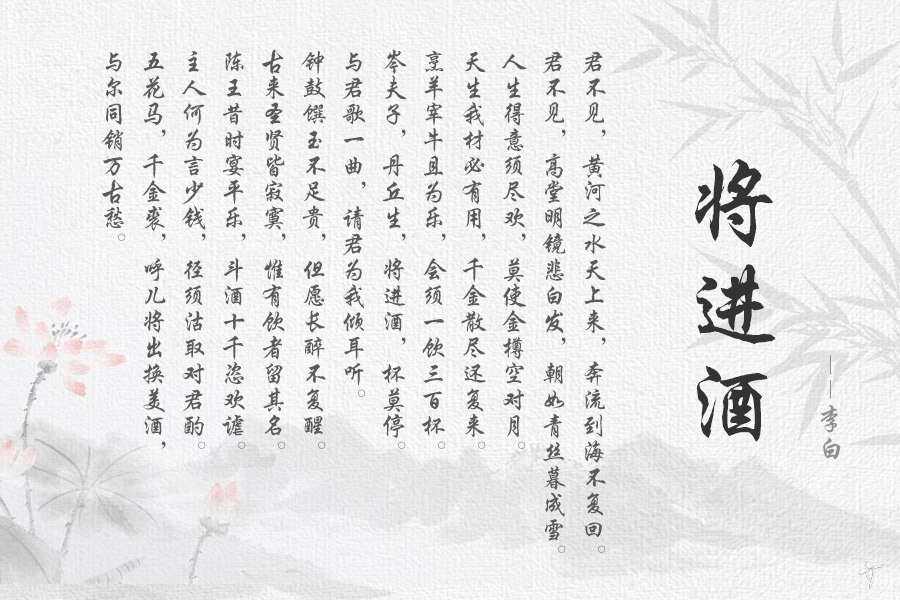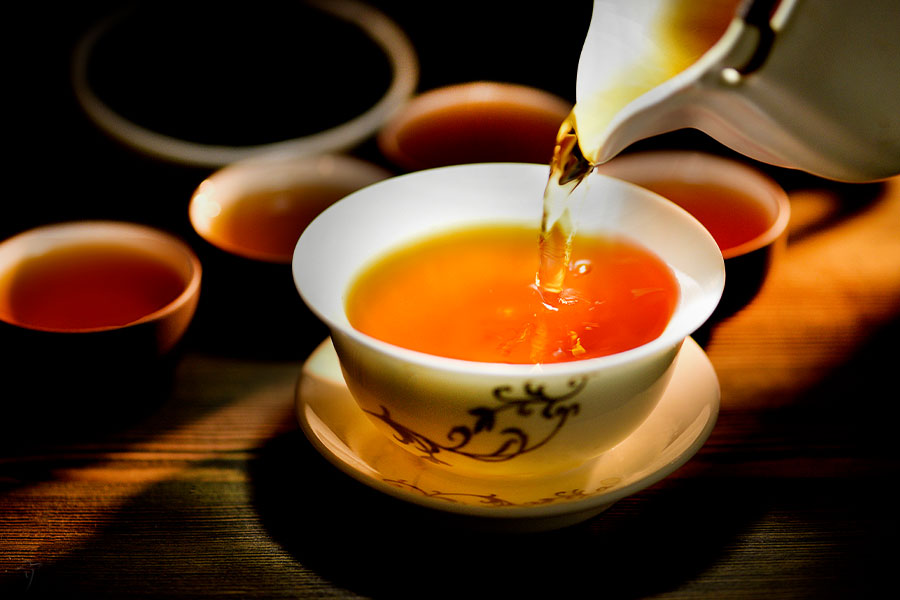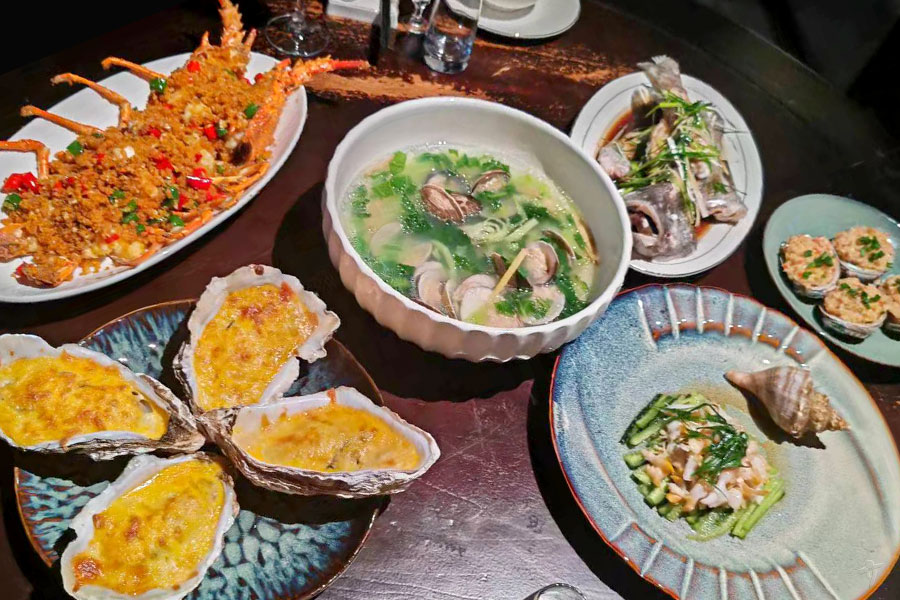Classical Chinese Poetry

Ancient Poetry (Pre-Tang Poetry)
Poetry is the central literary form in classical Chinese literature. The earliest poetry anthology is The Book of Songs (Chinese:《诗经》), which is the first monumental work in the history marking the beginning of Chinese literature. It was compiled by Confucius collecting about 300 poems from Western Zhou Dynasty (1100BC- 771BC) to Warring State Period (475BC- 221BC). Some of the poems are folk songs while others are songs used in sacrificial ceremonies or banquets.
Chuci, or Poems of Quanyuan (Chinese:楚辞) was created in Warring States Period by the great patriotic poet Quyuan (Chinese:屈原, 339BC- 278BC) who is regarded as the father of Chinese poetry. Chuci is originally a name of his poetry and later to be a style of his own with distinctive local features ofChuState. With this romantic style, Lisao (Chinese: 离骚》), the masterpiece of Quanquan consisting of 373 lines and 2490 characters, is the longest and greatest lyric in ancient China. It is also an outstanding example that deeply influenced classical Chinese literature just as the realistic style one done, The Book of Songs. And according to the story, the Dragon Boat Festival on the fifth day of the fifth lunar month is celebrated to commemorate this renowned patriotic poet, Quanyuan.
Started in Qin Dynasty (221BC- 207BC), Yuefu (Chinese:乐府), originally a name of an constitution established by government to collect folk songs and ballad, is a new narrative poetry style with strong reality sense prevailed in the two Han dynasties (202BC- 220AD). Mo Shang Sang (Chinese:《陌上桑》), the Flight of Phoenix to the Southeast (Chinese:《孔雀东南飞》), and Mulan Poetry (Chinese:《木兰诗》) are the representatives of this style. As Yuefu developed, poems with five or seven characters to a line were gradually standing out; with production of the Nineteenth Ancient Poem (Chinese:《古诗十九首》) in late Han Dynasty which won extremely high appraisal in the history of literature, five-character poem was basically formed, and seven-character poem was also formed soon afterwards.
In Wei, Jin, Southern and Northern dynasties, an outstanding poet Tao Yuanming (Chinese:陶渊明, 376-427) initiated a new idyllic poetry in the history after his retire from political life. He portrayed his seclusion life in his poetry and essays, the rural scenery and his engagement in farm work to support himself. Return to Rural Life (Chinese:《归去来辞》) is the masterpiece.
Tang Poetry (Modern Metrical Poetry)
Tang Dynasty (618-907) was an age of unprecedented prosperity both in economy and culture. Its literature, especially poetry, reached a zenith in history with numerous best-known poets and a wealth of poems. In the Complete Tang Poems(Chinese:《全唐诗》), about 48900 poems were collected belong to over 2300 poets. Libai (Chinese:李白, 701-762), Dupu (Chinese:杜甫, 712-770), and Baijuyi (Chinese:白居易, 772-846) are the most famous among them and many of their poems are famous home and abroad even today. Libai carried forward the fine literature tradition of romanticism in early Chinese poetry represented bu chuci and yuefu. He is regarded as the immortal of poetry (Chinese:诗仙). His poems are vigorous and enthusiastic, permeated with active romanticism. Dufu was the greatest poet of realism in ancient China, regarded as the sage of poetry (Chinese:诗圣). His poetry is a mirror of the society, just like a historical account faithfully and profoundly reflects the social realities of the Tang Dynasty in decline. Baijuyi is another influential Tang poet. His works are characterized by vivid image, plain language and profound sympathy for the ordinary people. More than 3000 of his poems have passed down, surpassing all other Tang poets in quantity.
Known as Tang poetry today, the modern metrical poetry of Tang Dynasty, is the most famous and central part in Chinese literature with greatest achievements. Tang poetry is metrical verse marked by strict tonal patterns and rhyme schemes. Jueju (Chinese:绝句, is a poem of four lines, each containing five or seven characters) and Lvshi (Chinese:律诗, is a poem of eight lines, each containing five or seven characters) are the two main forms.
The subjects of Tang poetry is in a wide range, some are side mirrors of class conflicts that exposed the darkness of feudal society, some are praises for just wars and patriotism, some are depiction of the beautiful country, some are the personal emotions about friendship, love, ambitions and life. In conclusion, natural phenomena, political events, labor life, social ethos and personal feelings are all captured by acute eyes of poets. In style of creation, there are realism and romantism, and most of the great poems are conjunct of these two styles. Though created over 1000 years ago, many of the poems are still widely circulated today which has far-reaching influenced in Chinese literature and the cultivation of the nation.
Song Poetry (Song Ci)
Song Ci (Chinese:宋词) also called Chang Duan Ju (Chinese:长短句, or lyrics), is a style of poetry with lines in different length started in Tang Dynasty and prevailed in Song Dynasty (960-1279). It is a brilliant gem reputed as Two Miracles in Chinese literature together with Tang Poetry.
In ancientChina, poetry was initially created as lyrics with music; it is the reason that Chinese classical poems are generally graceful and the tunes are quite catchy. Song Ci is the most typical lyrics combining music with great literature features in different styles with different expressions. Its emerging, development, creation and spread are all closely related to the music. Song Ci was created in a defined tune with a specific name, specific layout, rhythm, and numbers of characters in each line. Song Ci can be roughly divided into two schools, Wanyue School (Chinese:婉约派, graceful and restrained) and Haofang School (Chinese:豪放派, bold and unconstrained). Wanyue School was popular in early Song Dynasty which is graceful and immersed in love with restrained feelings, and outstanding representatives are Liu Yong (Chinese:柳永) and a female poet, Li Qingzhao (Chinese: 李清照); While Haofang School was popular in later period of Song Dynasty expressing bold and unconstrained emotions with broader perspectives, and representatives are Su Shi (Chinese:苏轼) and Xin Qiji (Chinese:辛弃疾).
Related Readings
Top Topics

Chinese Kung Fu
Far and wide known as Kungfu (功夫) all over the world, Chinese martial art is also called Wugong (武功) or Wushu (武术) at home by Chinese people. It ca...

Chinese Tea
Being a vivid Chinese cultural specialty as well as Kungfu and traditional Chinese medicine, Chinese tea has been being developed in China for a lo...

Chinese Cuisine
"Food is the first necessity of the people" is a famous Chinese old saying, which reflects that Chinese have had paid much attention to food si...




